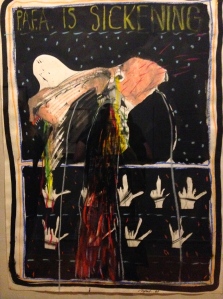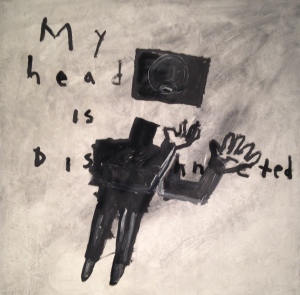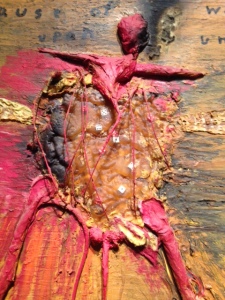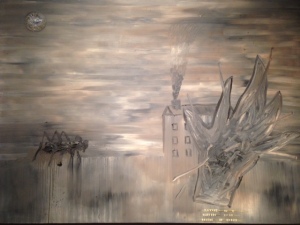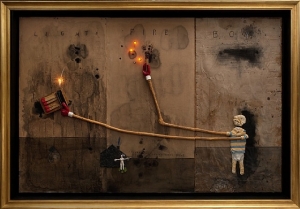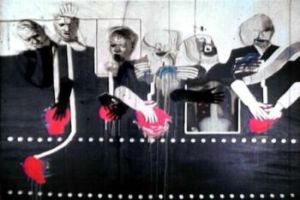Weird. Disturbing. Repulsive. Twisted. Uncomfortable. Darkly comedic.
No, I’m not talking about Thanksgiving with my family. I’m talking about David Lynch’s new art exhibit “The Unified Field” at the Pennsylvania Academy of Fine Arts, complete with parental disclaimer on the exhibition sign.
Visiting the David Lynch exhibit was, in a way, a homecoming for this Philly-area girl. Although the familiarity of the murals and buildings was comforting, I never really liked the city much: not quite the city of “fear, insanity, corruption, filth and despair,” that both revolted and inspired Lynch, but alienating nonetheless. Yet for all its grime, I appreciate Philly’s quirks. Where else can you observe a man in a business suit with an obscenely large wooden pipe in his mouth, driving around midday in his convertible with a license plate proclaiming his status as a “G”?
It felt uncanny being back at PAFA, this time as a college student. In high school I had studied oil painting there on Tuesday afternoons. So naturally, I felt pretty gosh darn special having studied at the same institution as THE David Lynch.
As an artist and frequent museum-goer, I like to think of myself as pretty open minded when it comes to art. Modern art can be tricky for me to appreciate, but I’ll always give it a chance (unlike my father, whose famous line is “If I can do it, it’s not art.”)
However, I found myself constantly checking my knee-jerk responses to Lynch’s art. Initially, I reacted to much of his art, as I did to his films, with revulsion or confusion. I dismissed many of his drawings as “childish” or unskilled.
Lynch has a reputation as a strange filmmaker, and he lives up to that reputation in this exhibition. But viewing his art after being exposed to his films in Greg Steirer’s American Auteurs class gave me a greater appreciation for Lynch’s work in both mediums, which explore similar themes of childhood, home, sex, violence, nightmares, and reality.
My biggest criticism is that Lynch’s approach to these themes was heavy-handed, trying too hard to be provocative or create shock value. I was very impressed by his use of texture, especially through mixed media. Lynch uses everything from cardboard and dolls to Band-Aids and bugs to endow his works with three-dimensionality and create an undeniably tactile and aesthetic experience for the viewer.
The near ubiquitous presence of words in Lynch’s paintings is another compelling aspect of his work, particularly in light of his statement that “There are things that can’t be said with words. And that’s sort of what painting is all about.” (Doesn’t using words in his paintings seem to subvert this claim?) Maybe it’s because I’m an English major and logophile, but I thought the words in Lynch’s works made his images more palatable; they gave me a reference point to hang on to, as well as added an element of beauty.
My favorite work was Shadow of a Twisted Hand Across My House, perhaps because it is more subdued. The neutral greys and impressionistic brushstrokes give this work a contemplative feel that belies a threat of danger. The New York Times’s Ken Johnson argues that Lynch’s puppet-sculptural works, like Boy Lights Fire, are his most impressive pieces, but these were actually my least favorite. Johnson thinks Lynch’s paintings of houses, trees, and human figures are nondescript, but I think they have power in their subtlety. It’s easy to hear you when you’re screaming; few people understand the power of a whisper.
I recommend this exhibition to David Lynch fans, or at least someone with a mild interest in the filmmaker and his oeuvre. Traditional art lovers and the squeamish be forewarned: you’ll be in for a rude awakening.
What better way to punctuate visiting an art exhibit that features vomit as a predominant theme (most notably in Lynch’s famous, prize-winning animated short, “Six Men Getting Sick”) than enjoying a cheesesteak from Reading Terminal Market? I mean, you can’t visit Philadelphia and not get a cheesesteak. Lynch aside, I missed you, Philly.
Interested? “David Lynch: The Unified Field” runs through Jan. 11 at the Pennsylvania Academy of the Fine Arts. To get a taste of the exhibition as a whole, check out this video on Philly.com. Let me know what you think of Lynch’s art in the comments below!

